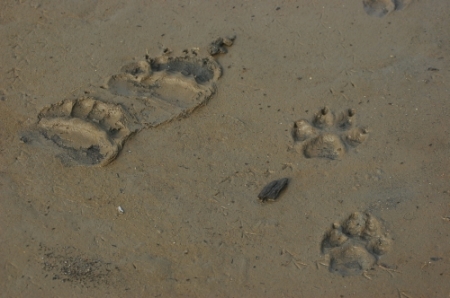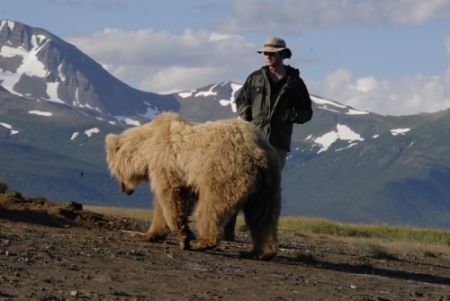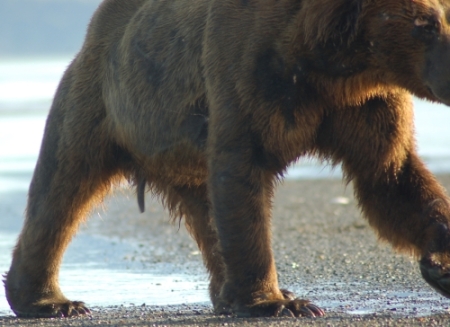 My husband John and I settle down in the grass to rest with our favorite grizzly bear “Cheetah” after she chose to approach us closely.
My husband John and I settle down in the grass to rest with our favorite grizzly bear “Cheetah” after she chose to approach us closely.
Archive for bears
Grizzly Bear Viewing
Posted in Cheetah, Grizzly bears and people with tags Alaska, animals, bears, grizzly bear, wildlife on November 8, 2011 by grizzlybearblogGrizzly Bear and Wolf Tracks
Posted in Alaska animals with tags Alaska, animals, bears, grizzly bears, wildlife, wolves on November 8, 2011 by grizzlybearblog A healthy Alaskan ecosystem will reveal the tracks of predators. Here, grizzly tracks are bordered in fresh wolf prints. The wolf population has been growing on the coast of Katmai National Park. The wolves use the beach as a highway and they trek the coastline during the few hours of summer darkness.
A healthy Alaskan ecosystem will reveal the tracks of predators. Here, grizzly tracks are bordered in fresh wolf prints. The wolf population has been growing on the coast of Katmai National Park. The wolves use the beach as a highway and they trek the coastline during the few hours of summer darkness.
Bears and wolves compete for food sources. During this past summer, guides witnessed wolves fishing for salmon alongside the grizzly bears on the Katmai coast.
Grizzly Bears Safely Near People
Posted in Grizzly bears and people with tags Alaska, animals, Bear Viewing, bears, brown bears, grizzly bears, wildlife on September 12, 2011 by grizzlybearblogGrizzly Bear Penis
Posted in Grizzly Bear Physiology, Male grizzlies with tags Alaska, animals, bears, brown bear, grizzly bears, wildlife on September 3, 2011 by grizzlybearblogBrown Bear Photo
Posted in Male grizzlies with tags bears, brown bear, grizzly bear on August 27, 2011 by grizzlybearblogGrizzly Bear Close Up Photo
Posted in Cheetah with tags Alaska, animal, bear, bears, grizzly bears, wildlife on August 25, 2011 by grizzlybearblogGrizzly Bear Viewing
Posted in Grizzly Bear Cubs, Grizzly bears and people with tags animals, bear cubs, Bear Viewing, bears, grizzly bear viewing, grizzly bears on August 22, 2011 by grizzlybearblog A grizzly bear viewer in Katmai N. Park watches a cub who is waiting for his mother. The mother dropped off her two cubs to sit with the small group of photographers while she fished the river for salmon. Grizzly bear mothers in certain areas of Katmai N. Park, who are habituated to bear viewers, have learned that humans are safe. They also have learned that being near bear viewers is a safe place for their cubs to rest.
A grizzly bear viewer in Katmai N. Park watches a cub who is waiting for his mother. The mother dropped off her two cubs to sit with the small group of photographers while she fished the river for salmon. Grizzly bear mothers in certain areas of Katmai N. Park, who are habituated to bear viewers, have learned that humans are safe. They also have learned that being near bear viewers is a safe place for their cubs to rest.
Blonde Grizzly Bear Clamming
Posted in Grizzly Bears Clamming with tags Alaska, animals, bear, bears, grizzly bears on August 11, 2011 by grizzlybearblog Clams are an important part of the grizzly bear diet on the coast of Alaska. Bears use their amazing sense of smell to locate clams under the sand. The extreme tidal variations in Alaska allow miles of the ocean floor to be uncovered at low tide – an excellent opportunity for clamming.
Clams are an important part of the grizzly bear diet on the coast of Alaska. Bears use their amazing sense of smell to locate clams under the sand. The extreme tidal variations in Alaska allow miles of the ocean floor to be uncovered at low tide – an excellent opportunity for clamming.
 You can see this female grizzly bear sniffing the surface of the sand to locate her next clam.
You can see this female grizzly bear sniffing the surface of the sand to locate her next clam.
Bears Salmon Fishing in August
Posted in Grizzly Bears Fishing with tags Alaska, bears, brown bears, fishing, grizzly bears, salmon on August 8, 2011 by grizzlybearblogGlacier N. Park Grizzly Attack
Posted in Uncategorized with tags Alaska, bear attacks, bears, grizzly bears on August 6, 2011 by grizzlybearblogEvery summer the few bear attacks that occur become instant front page news. Today reports surfaced of a hiker attacked by a mother grizzly bear with cubs in Glacier National Park, Montana. The hiker was injured but survived and was able to walk to help. With every news story comes the propagation of false information about bears. Last week, the NY Times reported in the article Human Run-Ins With Bears May Portend Deeper Changes that “Bears [are]— dangerous and unpredictable always —”. This information is simply not true (humans have been safely coexisting with grizzly bears in Katmai N. Park for decades), yet the media insists on teaching the public that bears are unpredictable monsters.
The truth is, bears are no more unpredictable than any other wild animal. The unpredictable myth is perhaps the deepest fear propagated by people who know nothing about bears! It is nearly impossible to watch a documentary or show on bears where they are not called “unpredictable” and where the narrator does not mention that bears are dangerous to people. Do they ever do this on shows about lions? Or cheetahs? Or hippos? No. But for some reason bears are always described as dangerous and unpredictable, even though there is no basis for this claim, especially in comparison to other predators (like humans) which kill many more people per year than bears.
And what is so wrong with “unpredictable” anyways? Being predictable means you are an organism that follows instinct only. More intelligent animals are less predictable because they can learn behavior, adapt to new situations, and use their brains to survive and not just rely on instinct. Grizzly bears, like humans or primates, are very intelligent opportunists. They learn to adapt to new situations, new food sources, new challenges, new threats. This is not inherently a bad thing, and does not translate into being indiscriminate killers! It simply means your brain adapts to new situations better than a grasshopper or a bee.
Bear attacks have been thoroughly studied and what we have learned is that most bear attacks occur when a bear is severely stressed. This can occur from injury, starvation, disease, or a shrinking eco system. As wild spaces are destroyed there is less and less space for predators to survive, and human-animal conflicts may be increased. But bear attacks are quite predictable and can be avoided. Most attacks occur when a hiker stumbles upon a cached prey, such as an elk or moose. Grizzlies are defensive around a large kill of meat. Mothers with cubs may also be defensive of their young, and require a greater amount of personal space to not feel threatened. But these are not fixed rules at all.
For example, in Katmai N. Park, where food is abundant and hunting prohibited, mother bears with cubs have learned that the safest place to be is NEAR humans. They have learned that male grizzlies tend to avoid getting close to human bear viewers, or the bear viewing stands in places like Brooks Falls. The mother grizzlies of Katmai actually stash their cubs with groups of human bear viewers to protect the cubs! One mother we knew very well would leave her cubs with us to babysit while she fished for salmon. This is a sign of the complex social intelligence of bears.
Here are a few bear attack statistics to also put things in perspective:
- You are 12 times more likely to die of a bee sting than a bear attack (120 times more likely compared to a black bear)
- You are 10 times more likely to die from a dog attack than a bear attack (45 times more likely compared to a black bear attack)
- 1 person out of 16,000 commits murder but only 1 grizzly bear out of 50,000 ever kills someone and only 1 black bear out of one million does. So people are much more dangerous than bears!
- There are about 750,000 black bears in North America and on average there is less than one black bear killing per year.
- For each person killed by a black bear attack there are 13 people killed by snakes, 17 by spiders, 45 by dogs, 120 by bees, 150 by tornadoes, 374 by lightning, and 60,000 by humans.
Now why are we so afraid of bears? Why do they make the front page, when the abuse, violence, rape, and murder by humans is so commonplace that it doesn’t even make it in the newspaper at all?
This is a complex issue, and I invite you to read two articles written by my husband and I:
Lastly, many attacks could be avoided if hikers carried hand held marine flares, which is the safety device used on the coast of Katmai N. Park. The flares can be clipped to your belt for easy access, and ignite by simply pulling a string. Bears will run due to their natural fear of fire, and the loud noise and smoke that the flare generates. You also don’t have to aim like bear spray. Other ways to prevent attacks include hiking and camping in groups larger than three, camping behind an electric fence, and making noise (talking, singing) when coming around blind curves in a trail to alert bears to your presence.




